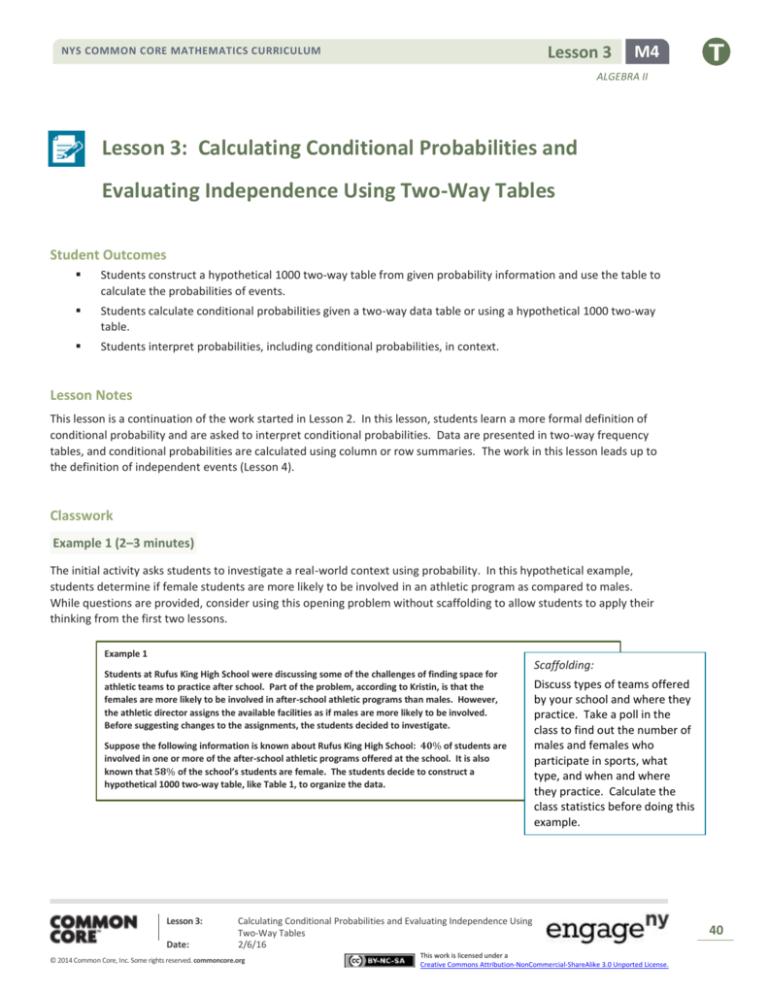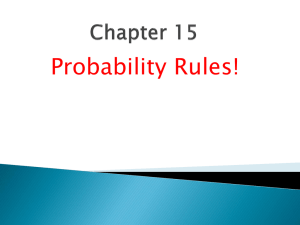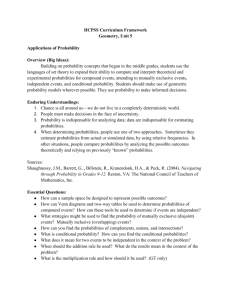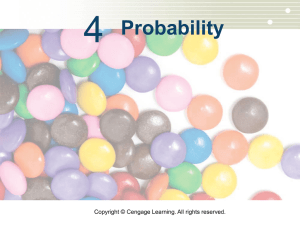
Lesson 3
NYS COMMON CORE MATHEMATICS CURRICULUM
M4
ALGEBRA II
Lesson 3: Calculating Conditional Probabilities and
Evaluating Independence Using Two-Way Tables
Student Outcomes
Students construct a hypothetical 1000 two-way table from given probability information and use the table to
calculate the probabilities of events.
Students calculate conditional probabilities given a two-way data table or using a hypothetical 1000 two-way
table.
Students interpret probabilities, including conditional probabilities, in context.
Lesson Notes
This lesson is a continuation of the work started in Lesson 2. In this lesson, students learn a more formal definition of
conditional probability and are asked to interpret conditional probabilities. Data are presented in two-way frequency
tables, and conditional probabilities are calculated using column or row summaries. The work in this lesson leads up to
the definition of independent events (Lesson 4).
Classwork
Example 1 (2–3 minutes)
The initial activity asks students to investigate a real-world context using probability. In this hypothetical example,
students determine if female students are more likely to be involved in an athletic program as compared to males.
While questions are provided, consider using this opening problem without scaffolding to allow students to apply their
thinking from the first two lessons.
Example 1
Students at Rufus King High School were discussing some of the challenges of finding space for
athletic teams to practice after school. Part of the problem, according to Kristin, is that the
females are more likely to be involved in after-school athletic programs than males. However,
the athletic director assigns the available facilities as if males are more likely to be involved.
Before suggesting changes to the assignments, the students decided to investigate.
Suppose the following information is known about Rufus King High School: 𝟒𝟎% of students are
involved in one or more of the after-school athletic programs offered at the school. It is also
known that 𝟓𝟖% of the school’s students are female. The students decide to construct a
hypothetical 1000 two-way table, like Table 1, to organize the data.
Lesson 3:
Date:
Scaffolding:
Discuss types of teams offered
by your school and where they
practice. Take a poll in the
class to find out the number of
males and females who
participate in sports, what
type, and when and where
they practice. Calculate the
class statistics before doing this
example.
Calculating Conditional Probabilities and Evaluating Independence Using
Two-Way Tables
2/6/16
© 2014 Common Core, Inc. Some rights reserved. commoncore.org
This work is licensed under a
Creative Commons Attribution-NonCommercial-ShareAlike 3.0 Unported License.
40
Lesson 3
NYS COMMON CORE MATHEMATICS CURRICULUM
M4
ALGEBRA II
Table 1
Participation in after-school athletic program (Yes or No) by gender
Yes - Participate in After-School
Athletic Program
Cell 1
Cell 4
Cell 7
Females
Males
Total
No - Do Not Participate in AfterSchool Athletic Program
Cell 2
Cell 5
Cell 8
Total
Cell 3
Cell 6
Cell 9
Exercises 1–6 (10-15 minutes): Organizing the Data
Let students work with a partner and then confirm answers as a class. Exercise 3 requires students to express their
MP.2 thinking, reasoning from the table abstractly and quantitatively. As students calculate the probabilities, they need to
interpret them in context.
Exercises 1–6: Organizing the Data
1.
What cell in Table 1 represents a hypothetical group of 𝟏, 𝟎𝟎𝟎 students at Rufus King High School?
Cell 𝟗
2.
What cells in Table 1 can be filled based on the information given about the student population? Place these values
in the appropriate cells of the table based on this information.
Cells 𝟑 and 𝟕 can be completed from the given information. See completed table below.
3.
Based only on the cells you completed in Exercise 2, which of the following probabilities can be calculated, and
which cannot be calculated? Calculate the probability if it can be calculated. If it cannot be calculated, indicate why.
a.
The probability that a randomly selected student is female.
Yes, this can be calculated. The probability is 𝟎. 𝟓𝟖.
b.
The probability that a randomly selected student participates in after school athletics programs.
Yes, this can be calculated. The probability is 𝟎. 𝟒𝟎.
c.
The probability that a randomly selected student who does not participate in the after school athletics
program is male.
No, this probability cannot be calculated. We need to know the value of cell 𝟓 to calculate this probability.
d.
The probability that a randomly selected male student participates in the after school athletics program.
No, this probability cannot be calculated. We need to know the value of cell 𝟒 to calculate this probability.
4.
The athletic director indicated that 𝟐𝟑. 𝟐% of the students at Rufus King are females and participate in after school
athletics programs. Based on this information, complete Table 𝟏.
A completed table is given below:
Females
Males
Total
Lesson 3:
Date:
Yes - Participate in AfterSchool Athletic Program
𝟐𝟑𝟐
𝟏𝟔𝟖
𝟒𝟎𝟎
No - Do Not Participate in AfterSchool Athletic Program
𝟑𝟒𝟖
𝟐𝟓𝟐
𝟔𝟎𝟎
Total
𝟓𝟖𝟎
𝟒𝟐𝟎
𝟏, 𝟎𝟎𝟎
Calculating Conditional Probabilities and Evaluating Independence Using
Two-Way Tables
2/6/16
© 2014 Common Core, Inc. Some rights reserved. commoncore.org
This work is licensed under a
Creative Commons Attribution-NonCommercial-ShareAlike 3.0 Unported License.
41
Lesson 3
NYS COMMON CORE MATHEMATICS CURRICULUM
M4
ALGEBRA II
5.
Consider the cells 𝟏, 𝟐, 𝟒, and 𝟓 of Table 1. Identify which of these cells represent students who are female or who
participate in after-school athletic programs.
Cells 𝟏, 𝟐, and 𝟒.
6.
What cells of the two-way table represent students who are males who do not participate in after-school athletic
programs?
Cell 𝟓.
Example 2 (2–3 minutes)
The following definitions were first introduced in Grade 7. It is important, however, that students revisit the definitions
of complement, union, and intersection. The definitions in this lesson are connected to the context of the data and do
not focus on a symbolic representation of these terms. The use of Venn diagrams and sets to represent these events is
developed in Lessons 7 and 8.
Example 2
The completed hypothetical 1000 table organizes information in a way that makes it possible to answer various
questions. For example, you can investigate whether females at the school are more likely to be involved in the afterschool athletic programs.
Consider the following events:
Let “𝑨” represent the event “a randomly selected student is female.”
Let “not 𝑨” represent the “complement of 𝑨.” The complement of 𝑨 represents the event “a randomly
selected student is not female,” which is equivalent to the event “a randomly selected student is male.”
Let “𝑩” represent the event “a randomly selected student participates in the after-school athletic program.”
Let “not 𝑩” represent the “complement of 𝑩.” The complement of 𝑩 represents the event “a randomly
selected student does not participate in the after-school athletic program.”
Let “𝑨 or 𝑩” (described as 𝑨 union 𝑩) represent the event “a randomly selected student is female or
participates in the after-school athletic program.”
Let “𝑨 and 𝑩” (described as 𝑨 intersect 𝑩) represent the event “a randomly selected student is female and
participates in the after-school athletic program.”
Exercises 7–9 (8–10 minutes)
Let students continue to work with their partner and confirm answers as a class.
Exercises 7–9
7.
Based on the descriptions above, describe the following events in words:
a.
Not 𝑨 or Not 𝑩.
Males or students not participating in the after-school athletic program.
b.
𝑨 and Not 𝑩.
Females not participating in the after-school athletic program.
Lesson 3:
Date:
Calculating Conditional Probabilities and Evaluating Independence Using
Two-Way Tables
2/6/16
© 2014 Common Core, Inc. Some rights reserved. commoncore.org
This work is licensed under a
Creative Commons Attribution-NonCommercial-ShareAlike 3.0 Unported License.
42
Lesson 3
NYS COMMON CORE MATHEMATICS CURRICULUM
M4
ALGEBRA II
8.
Based on the above descriptions and Table 1, determine the probability of each of the following events:
a.
𝑨
𝟓𝟖𝟎
or 𝟎. 𝟓𝟖
𝟏𝟎𝟎𝟎
b.
𝑩
𝟒𝟎𝟎
or 𝟎. 𝟒𝟎
𝟏𝟎𝟎𝟎
c.
Not 𝑨
𝟒𝟐𝟎
or 𝟎. 𝟒𝟐
𝟏𝟎𝟎𝟎
d.
Not 𝑩
𝟔𝟎𝟎
or 𝟎. 𝟔𝟎
𝟏𝟎𝟎𝟎
e.
𝑨 or 𝑩
𝟐𝟑𝟐+𝟑𝟒𝟖+𝟏𝟔𝟖
𝟕𝟒𝟖
=
or 𝟎. 𝟕𝟒𝟖
𝟏𝟎𝟎𝟎
𝟏𝟎𝟎𝟎
f.
𝑨 and 𝑩
𝟐𝟑𝟐
or 𝟎. 𝟐𝟑𝟐
𝟏𝟎𝟎𝟎
9.
Determine the following values:
a.
The probability of 𝑨 plus the probability of Not 𝑨.
The sum is 𝟏. 𝟎𝟎𝟎 or 𝟎. 𝟓𝟖𝟎 + 𝟎. 𝟒𝟐𝟎 = 𝟏. 𝟎𝟎𝟎.
b.
The probability of 𝑩 plus the probability of Not 𝑩.
The sum is 𝟏. 𝟎𝟎𝟎 or 𝟎. 𝟒𝟎𝟎𝟎 + 𝟎. 𝟔𝟎𝟎𝟎 = 𝟏. 𝟎𝟎𝟎.
c.
What do you notice about the results of parts (a) and (b)? Explain.
Both probabilities total 𝟏. This makes sense since both parts are asking for the probability of 𝑨 and not 𝑨 or
𝑩 and not 𝑩.
Example 3 (2 minutes): Conditional Probability
Read through the example as a class. Help students identify how the conditional probabilities are not based on the
whole population but rather on a specific subgroup within the whole population that is represented by a row total or a
column total. The visual of pulling apart the two-way table by rows or columns is intended to help you develop this idea
with students.
Lesson 3:
Date:
Calculating Conditional Probabilities and Evaluating Independence Using
Two-Way Tables
2/6/16
© 2014 Common Core, Inc. Some rights reserved. commoncore.org
This work is licensed under a
Creative Commons Attribution-NonCommercial-ShareAlike 3.0 Unported License.
43
Lesson 3
NYS COMMON CORE MATHEMATICS CURRICULUM
M4
ALGEBRA II
Example 3: Conditional Probability
Another type of probability is called a conditional probability. Pulling apart the two-way table helps to define a
conditional probability.
Females
Yes - Participate in After-School
Athletic Program
Cell 𝟏
No - Do Not Participate in AfterSchool Athletic Program
Cell 𝟐
Total
Cell 𝟑
Suppose that a randomly selected student is female. What is the probability that the selected student participates in the
after-school athletic program? This probability is an example of what is called a conditional probability. This probability
is calculated as the number of students who are female students and participate in the after-school athletic program (or
the students in cell 𝟏) divided by the total number of female students (or the students in cell 𝟑).
Exercises 10–15 (8–10 minutes)
The following exercises are designed to have students calculate and interpret conditional probabilities based on data in
two-way tables. The conditional probabilities are based on focusing on either a row or a column in the table. Let
students work with a partner and confirm answers as a class. Students are calculating probabilities and connecting the
probability to the context. In these questions, students must make the connection to a subgroup within the population
MP.2
identified by the desired conditional probability. Both the calculation of the conditional probability and its meaning in
context are developed with these questions.
Exercises 10–15
10. The following are also examples of conditional probabilities. Answer each question.
a.
What is the probability that if a randomly selected student is female, she participates in the after-school
athletic program?
Cell 𝟏
𝟐𝟑𝟐
=
or 𝟎. 𝟒𝟎
Cell 𝟑
𝟓𝟖𝟎
b.
What is the probability that if a randomly selected student is female, she does not participate in after-school
athletics?
Cell 𝟐
𝟑𝟒𝟖
=
or 𝟎. 𝟔𝟎
Cell 𝟑 𝟓𝟖𝟎
11. Describe two conditional probabilities that can be determined from the following row in Table 1.
Males
Yes - Participate in After-School
Athletic Program
Cell 𝟒
No - Do Not Participate in AfterSchool Athletic Program
Cell 𝟓
Total
Cell 𝟔
The probability that if a randomly selected student is male, he participates in the after-school athletic program.
The probability that if a randomly selected student is male, he does not participate in the after-school athletic
program.
Lesson 3:
Date:
Calculating Conditional Probabilities and Evaluating Independence Using
Two-Way Tables
2/6/16
© 2014 Common Core, Inc. Some rights reserved. commoncore.org
This work is licensed under a
Creative Commons Attribution-NonCommercial-ShareAlike 3.0 Unported License.
44
Lesson 3
NYS COMMON CORE MATHEMATICS CURRICULUM
M4
ALGEBRA II
12. Describe two conditional probabilities that can be determined from the following column in Table 1.
Females
Males
Total
Yes - Participate in After-School
Athletic Program
Cell 𝟏
Cell 𝟒
Cell 𝟕
The probability that if a randomly selected student participates in the after-school athletic program, the student is a
female.
The probability that if a randomly selected student participates in the after-school athletic program, the student is a
male.
13. Determine the following conditional probabilities.
a.
A randomly selected student is female. What is the probability she participates in the after-school athletic
program? Explain how you determined your answer.
𝟐𝟑𝟐
= 𝟎. 𝟒𝟎
𝟓𝟖𝟎
Since it is known that the selected student is female, I looked at the row for females and used that
information.
b.
A randomly selected student is male. What is the probability he participates in the after-school athletic
program?
𝟏𝟔𝟖
= 𝟎. 𝟒𝟎
𝟒𝟐𝟎
c.
A student is selected at random. What is the probability this student participates in the after-school athletic
program?
𝟒𝟎𝟎
= 𝟎. 𝟒𝟎
𝟏𝟎𝟎𝟎
14. Based on the answers to Exercise 13, do you think that female students are more likely to be involved in after-school
athletics? Explain your answer.
No, the conditional probabilities indicate males and females are equally likely to be involved in the after-school
athletic program.
15. What might explain the concern females expressed in the beginning of this lesson about the problem of assigning
space?
It is interesting that at this school, the probability that a randomly selected student is female is 𝟎. 𝟓𝟖. There are
more females at this school. As a result, if facilities are assigned equally (given that both females and males were
found to be equally likely to be involved), the number of females involved in the after-school program is greater than
the number of males and might explain the concern regarding facilities.
Lesson 3:
Date:
Calculating Conditional Probabilities and Evaluating Independence Using
Two-Way Tables
2/6/16
© 2014 Common Core, Inc. Some rights reserved. commoncore.org
This work is licensed under a
Creative Commons Attribution-NonCommercial-ShareAlike 3.0 Unported License.
45
Lesson 3
NYS COMMON CORE MATHEMATICS CURRICULUM
M4
ALGEBRA II
Closing (5 minutes)
What did the probabilities tell us about the students at Rufus King High School?
Answers will vary. Anticipate that students might mention that there are more females than males or
that males and females are equally likely to be involved in after-school athletics (based on the
conditional probabilities). Use this question to help students understand the difference between
probabilities based on the whole population and probabilities based on a row or column of the table
(conditional probabilities).
Ask students to summarize the main ideas of the lesson in writing or with a neighbor. Use this opportunity to informally
assess student comprehension of the lesson. The Lesson Summary below offers some important ideas that should be
included.
Lesson Summary
Data organized in a two-way frequency table can be used to calculate probabilities. The two-way frequency tables
can also be used to calculate conditional probabilities.
In certain problems, probabilities that are known can be used to create a hypothetical 1000 two-way table. This
hypothetical population of 𝟏, 𝟎𝟎𝟎 can be used to calculate conditional probabilities.
Probabilities are always interpreted by the context of the data.
Exit Ticket (5 minutes)
Lesson 3:
Date:
Calculating Conditional Probabilities and Evaluating Independence Using
Two-Way Tables
2/6/16
© 2014 Common Core, Inc. Some rights reserved. commoncore.org
This work is licensed under a
Creative Commons Attribution-NonCommercial-ShareAlike 3.0 Unported License.
46
Lesson 3
NYS COMMON CORE MATHEMATICS CURRICULUM
M4
ALGEBRA II
Name
Date
Lesson 3: Calculating Conditional Probabilities and Evaluating
Independence Using Two-Way Tables
Exit Ticket
A state nonprofit organization wanted to encourage its members to consider the State of New York as a vacation
destination. They are investigating whether their online ad campaign influenced its members to plan a vacation in New
York within the next year. The organization surveyed its members and found that 75% of them have seen the online ad.
40% of its members indicated they are planning to vacation in New York within the next year, and 15% of its members
did not see the ad and do not plan to vacation in New York within the next year.
Complete the following hypothetical 1000 two-way frequency table:
Plan to vacation in New York
within the next year
Do not plan to vacation in New
York within the next year
Total
Watched the online ad
Did not watch the
online ad
Total
Based on the two-way table, describe two conditional probabilities you could calculate to help decide if members
who saw the online ad are more likely to plan a vacation in New York within the next year than those who did not
see the ad.
Lesson 3:
Date:
Calculating Conditional Probabilities and Evaluating Independence Using
Two-Way Tables
2/6/16
© 2014 Common Core, Inc. Some rights reserved. commoncore.org
This work is licensed under a
Creative Commons Attribution-NonCommercial-ShareAlike 3.0 Unported License.
47
Lesson 3
NYS COMMON CORE MATHEMATICS CURRICULUM
M4
ALGEBRA II
Calculate the probabilities you described in Problem 2.
Based on the probabilities calculated in Problem 3, do you think the ad campaign is effective in encouraging people
to vacation in New York? Explain your answer.
Lesson 3:
Date:
Calculating Conditional Probabilities and Evaluating Independence Using
Two-Way Tables
2/6/16
© 2014 Common Core, Inc. Some rights reserved. commoncore.org
This work is licensed under a
Creative Commons Attribution-NonCommercial-ShareAlike 3.0 Unported License.
48
Lesson 3
NYS COMMON CORE MATHEMATICS CURRICULUM
M4
ALGEBRA II
Exit Ticket Sample Solutions
A state nonprofit organization wanted to encourage its members to consider the State of New York as a vacation
destination. They are investigating whether their online ad campaign influenced its members to plan a vacation in New
York within the next year. The organization surveyed its members and found 𝟕𝟓% of them have seen the online ad. 𝟒𝟎%
of its members indicated they are planning to vacation in New York within the next year, and 𝟏𝟓% of its members did not
see the ad and do not plan to vacation in New York within the next year.
1.
Complete the following hypothetical 1000 two-way frequency table:
Watched the online ad
Did not watch the
online ad
Total
2.
Plan to vacation in New York
within the next year
𝟑𝟎𝟎
Do not plan to vacation in New
York within the next year
𝟒𝟓𝟎
𝟏𝟎𝟎
𝟏𝟓𝟎
𝟐𝟓𝟎
𝟒𝟎𝟎
𝟔𝟎𝟎
𝟏, 𝟎𝟎𝟎
Total
𝟕𝟓𝟎
Based on the two-way table, describe two conditional probabilities you could calculate to help decide if members
who saw the online ad are more likely to plan a vacation in New York within the next year than those who did not
see the ad.
The probability that a randomly selected member who watched the ad is planning to vacation in New York.
The probability that a randomly selected member who did not watch the ad is planning to vacation in New York.
3.
Calculate the probabilities you described in Problem 2.
𝟑𝟎𝟎
or approximately
𝟕𝟓𝟎
𝟏𝟎𝟎
𝟎. 𝟒𝟎𝟎. The probability that a member who did not watch the ad is planning vacation in New York is
or
𝟐𝟓𝟎
The probability that a member who watched the ad is planning a vacation in New York is
approximately 𝟎. 𝟒𝟎𝟎.
4.
Based on the probabilities calculated in Problem 3, do you think the ad campaign is effective in encouraging people
to vacation in New York? Explain your answer.
The conditional probabilities are the same. It does not appear that the ad campaign is encouraging people to
vacation in New York.
Problem Set Sample Solutions
Oostburg College has a rather large marching band. Engineering majors were heard bragging that students majoring in
engineering are more likely to be involved in the marching band than students from other majors.
1.
If the above claim is accurate, does that mean that most of the band is engineering students? Explain your answer.
No, it means that if a randomly selected student is an engineering major, the probability this person is in the
marching band is greater than if this person was not an engineering major.
Lesson 3:
Date:
Calculating Conditional Probabilities and Evaluating Independence Using
Two-Way Tables
2/6/16
© 2014 Common Core, Inc. Some rights reserved. commoncore.org
This work is licensed under a
Creative Commons Attribution-NonCommercial-ShareAlike 3.0 Unported License.
49
Lesson 3
NYS COMMON CORE MATHEMATICS CURRICULUM
M4
ALGEBRA II
2.
The following graph was prepared to investigate the above claim.
Based on the graph, complete the following two-way frequency table:
Engineering major
Not an
engineering major
Total
3.
In the Marching Band
𝟒𝟎
Not in the Marching Band
𝟏𝟑𝟓
Total
𝟏𝟕𝟓
𝟏𝟐𝟎
𝟓𝟏𝟎
𝟔𝟑𝟎
𝟏𝟔𝟎
𝟔𝟒𝟓
𝟖𝟎𝟓
Let 𝑴 represent the event that a randomly selected student is in the marching band. Let 𝑬 represent the event that
a randomly selected student is an engineering major.
a.
Describe the event represented by the complement of 𝑴.
A randomly selected student is not in the marching band.
b.
Describe the event represented by the complement of 𝑬.
A randomly selected student is not majoring in engineering.
c.
Describe the event 𝑨 and 𝑩 (𝑨 intersect 𝑩).
A randomly selected student is majoring in engineering and is in the marching band.
d.
Describe the event 𝑨 or 𝑩 (𝑨 union 𝑩).
A randomly selected student is majoring in engineering or is in the marching band.
Note: The union can be a challenge for students to describe or to identify. Start with one of the joint cells of the twoway table. Ask if the joint cell includes students majoring in engineering or students in the marching band. If either
description applies, then that cell is part of the union. Work through each of the joint cells in this way to identify all of
the cells that compose the union.
Lesson 3:
Date:
Calculating Conditional Probabilities and Evaluating Independence Using
Two-Way Tables
2/6/16
© 2014 Common Core, Inc. Some rights reserved. commoncore.org
This work is licensed under a
Creative Commons Attribution-NonCommercial-ShareAlike 3.0 Unported License.
50
Lesson 3
NYS COMMON CORE MATHEMATICS CURRICULUM
M4
ALGEBRA II
4.
Based on the completed two-way frequency table, determine the following and explain how you got your answer.
a.
The probability that a randomly selected student is in the marching band.
𝟏𝟔𝟎
≈ 𝟎. 𝟏𝟗𝟗
𝟖𝟎𝟓
I compared the number of students in marching band to the total number of number of students.
b.
The probability that a randomly selected student is an engineering major.
𝟏𝟕𝟓
≈ 𝟎. 𝟐𝟏𝟕
𝟖𝟎𝟓
I compared the number of engineering majors to the total number of students.
c.
The probability that a randomly selected student is in the marching band and an engineering major.
𝟒𝟎
≈ 𝟎. 𝟎𝟓
𝟖𝟎𝟓
I found the number of students who are in the band and are engineering majors and compared it to the total
number of students.
d.
The probability that a randomly selected student is in the marching band and not an engineering major.
𝟏𝟐𝟎
≈ 𝟎. 𝟏𝟒𝟗
𝟖𝟎𝟓
I found the number of students who are in the band and are NOT engineering majors and compared it to the
total number of students.
5.
Indicate if the following conditional probabilities would be calculated using the rows or the columns of the two-way
frequency table.
a.
A randomly selected student is majoring in engineering. What is the probability this student is in the
marching band?
This probability is based on the row “Engineering major.”
b.
A randomly selected student is not in the marching band. What is the probability that this student is
majoring in engineering?
This probability is based on the column “Not in the Marching Band.”
6.
Based on the two-way frequency table, determine the following conditional probabilities.
a.
A randomly selected student is majoring in engineering. What is the probability that this student is in the
marching band?
𝟒𝟎
≈ 𝟎. 𝟐𝟐𝟗
𝟏𝟕𝟓
b.
A randomly selected student is not majoring in engineering. What is the probability that this student is in the
marching band?
𝟏𝟐𝟎
≈ 𝟎. 𝟏𝟗𝟎
𝟔𝟑𝟎
Lesson 3:
Date:
Calculating Conditional Probabilities and Evaluating Independence Using
Two-Way Tables
2/6/16
© 2014 Common Core, Inc. Some rights reserved. commoncore.org
This work is licensed under a
Creative Commons Attribution-NonCommercial-ShareAlike 3.0 Unported License.
51
Lesson 3
NYS COMMON CORE MATHEMATICS CURRICULUM
M4
ALGEBRA II
7.
The claim that started this investigation was that students majoring in engineering are more likely to be in the
marching band than students from other majors. Describe the conditional probabilities that would be used to
determine if this claim is accurate.
Given a randomly selected student is an engineering major, what is the probability the student is in the marching
band. Also, given a randomly selected student is not an engineering major, what is the probability the student is in
the marching band.
8.
Based on the two-way frequency table, calculate the conditional probabilities identified in Problem 7.
The probabilities were calculated in Problem 6. Approximately 𝟎. 𝟐𝟐𝟗 (or 𝟐𝟐. 𝟗%) of the engineering students are in
the marching band. Approximately 𝟎. 𝟏𝟗𝟎 (or 𝟏𝟗. 𝟎%) of the students not majoring in engineering are in the
marching band.
9.
Do you think the claim that students majoring in engineering are more likely to be in the marching band than
students for other majors is accurate? Explain your answer.
The claim is accurate based on the conditional probabilities.
10. There are 𝟒𝟎 students at Oostburg College majoring in computer science. Computer science is not considered an
engineering major. Calculate an estimate of the number of computer science majors you think are in the marching
band. Explain how you calculated your estimate.
The probability that a randomly selected student who is not majoring engineering is in the marching band is 𝟎. 𝟏𝟗𝟎.
As result, you would estimate that 𝟏𝟗% of the 𝟒𝟎 computer science majors are in the marching band. This would be
𝟒𝟎(𝟎. 𝟏𝟗𝟎) or approximately 𝟕 or 𝟖 students.
Lesson 3:
Date:
Calculating Conditional Probabilities and Evaluating Independence Using
Two-Way Tables
2/6/16
© 2014 Common Core, Inc. Some rights reserved. commoncore.org
This work is licensed under a
Creative Commons Attribution-NonCommercial-ShareAlike 3.0 Unported License.
52








